Arts
Changing face of Vesak
View(s):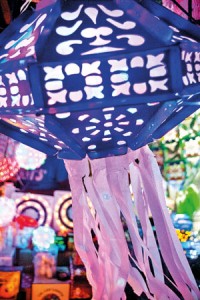 Did you make your Vesak lanterns at home last week? Chances are the delicate ‘kudus’ suspended above your porch were not your handiwork. Gone are the days when making lanterns was essentially a family effort -bamboo and tissue paper pasted together with ‘paappa’ – a sticky paste made by mixing water with flour. Children would get together to tie the bamboo, then apply paappa and finally paste on the tissue paper, complete with ‘ralli’, or waves made by cutting the tissue paper into strips. However, today the trend is to simply buy them readymade – at least the frames and replacing the flimsy tissue are a variety of different materials.
Did you make your Vesak lanterns at home last week? Chances are the delicate ‘kudus’ suspended above your porch were not your handiwork. Gone are the days when making lanterns was essentially a family effort -bamboo and tissue paper pasted together with ‘paappa’ – a sticky paste made by mixing water with flour. Children would get together to tie the bamboo, then apply paappa and finally paste on the tissue paper, complete with ‘ralli’, or waves made by cutting the tissue paper into strips. However, today the trend is to simply buy them readymade – at least the frames and replacing the flimsy tissue are a variety of different materials.The recent deluge has proven that these fragile lanterns need to be at least covered for protection in transparent plastic. Cloth has begun to replace the tissue paper as a more reliable material – but at a price. A set of seven cloth ‘nelum mal’ or lotus flowers at Rajagiriya were being sold at Rs. 8500. Other lanterns were relatively lower in price. Their frames however, were made of plastic and cardboard instead of the usual bamboo. The change in material is attributed to the scarcity of bamboo and the change in weather patterns.
Sita, who has been selling lanterns for the past eight years, feels that people’s attitudes toward the materials used in making lanterns is what has brought about this change. ‘Api wadiyen hadanne illuma wadidrawyawalin’ she says – (they make the lanterns in the materials which have the most demand.) Apart from plastic and cardboard, they have also started using wood. The field where she is based is covered in hundreds of frames which are clearly at the mercy of the elements. All that’s required for the lanterns to be completed is for them to be covered in paper – or cloth, as the case may be.
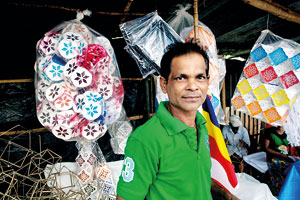
Tissa Wijesinghe: Good business in plastic kudus. Pix by Dilantha Dissanayake
Tissa Wijesinghe, 48, has been selling lanterns at the top of Justice Akbar Mawatha in Slave Island for the past 14 years. They are mainly made of glass paper, tissue paper and cardboard. He feels that ‘atapattam’ – the famous octagonal Vesak lanterns, are the fastest moving, hinting at the fact that tradition is still important. However, he has a growing business in plastic frames. “The only reason they don’t sell even faster is the fact that they are not built to last and so people buy one to try it out and often don’t buy more,” he says.
On 1st Cross Street in Pettah, we find Wedage Lalith Pushpa Kumara who sells only plastic frames, priced from Rs. 60 to Rs. 100, depending on shape and size; all are of the ‘atapattam’ shape or a variation of the octagon. He says he started selling the plastic frames two years ago. The origin of the frames is a closely guarded secret, it seems, because people don’t want the competition to know where their goods are from. We are assured that they are made in Sri Lanka though. Kumara feels that this in itself is a good omen for the island. “We should be happy that we have the technology to make these here instead of in China,” he says, adding that ‘meka ratatama adambarayak’ — this is something Sri Lanka should be proud of.
However, he adds a word of warning that the lanterns could be dangerous because plastic is highly flammable. He is also a believer in doing things the traditional way. “It is fine for people who are busy to buy these things. But to reduce the long and laborious process of cutting bamboo, tying and pasting it up to assembling a few pieces of plastic is not good. This makes ‘preethivesak’ (happy Vesak) into ‘kshenikavesak’ (instant Vesak). People must stop following the trends of others and if they are not busy they should make them,”’ he says.
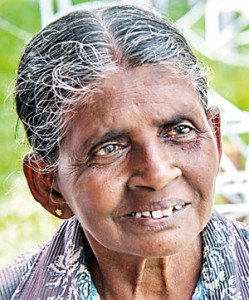
Right next to Kumara is Lakmal, who sells lanterns ranging from Rs. 100 – 200. He has been selling Vesak lanterns for over seven years and he feels that there has been a rise in demand for cardboard lanterns. The ‘atapattam’ sell well he says. “People are used to readymade things and these are really pretty so they buy them,” he says, gesturing to lanterns made in a multitude of colours of varying sizes, but mostly in the shape of an octagon.
In Havelock Town we meet Sunanda, who sells lanterns made of bamboo and cardboard – all covered in tissue paper. He says that the cardboard sells well because it’s slightly cheaper but the popularity of the classic bamboo makes it a favourite choice. ‘An eight-inch octagon made of bamboo is Rs. 300 while an eight-inch octagon made of cardboard is Rs. 250. Some people buy cardboard because it’s cheaper but most will pay Rs. 50 extra for the ones made of bamboo so both sell,” he says.
The line of shops in front of Kirulapone also give us a good idea of what sells and why. The first shop we visit is run by brothers Nishantha and Ranjith. Nishantha, 45, says that he has been selling lanterns for 30 years, ever since he was 15. There has been a greater demand for cardboard over the years, he says. His lanterns range from Rs. 50 – Rs. 300. An added attraction are the Chinese lanterns which he brings from Pettah. ‘Many non-Buddhists buy Chinese lanterns and they hang them up to join in the celebration of Vesak. I have many customers coming in and saying that they are buying these lanterns for their children to enjoy. But Buddhists mostly buy ‘attapattam’,” he says.
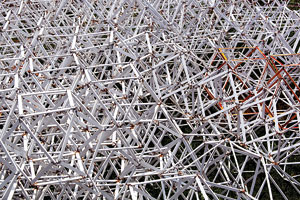
The most interesting item which we saw for sale was a Vesak lantern made in the shape of a dagaba, or stupa, with a diamond shaped outer frame made of bits of wire. Its creator Sivakumar, 42, feels that the demand for lanterns made of tissue paper has gone down and now he makes frames of bamboo so that his customers can paste them with whatever material they fancy. “People buy my frames and say they plan to paste them with coconut husk and various different and novel materials so now I just make the frames,” he says.
Clearly changing weather patterns and busy lifestyles of the modern Buddhist have impacted the way Vesak is celebrated but cloth or plastic, the lanterns continue to glow.
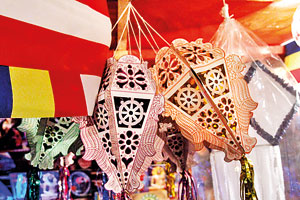
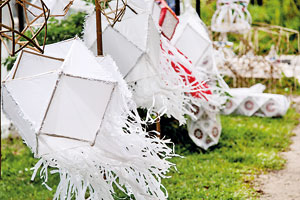
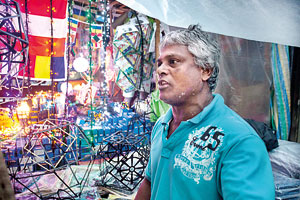
Pushpa Kumara: Happy to be selling Lankan-made lanterns

